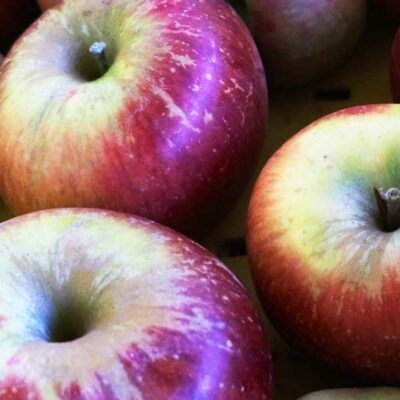Garden Plant: Melrose Apple Tree
Product Description: Melrose Apple Tree

Delicious Keeper Melrose Apple Tree
- Mid-Season
- 1000 Chill Hours
- Excellent Flavor
- Yellowish Green Skinned With Russet Spots and Dark Red Blush
- High Quality Creamy White Flesh
- Use For Sauces, Cooking and Dessert
- Great Keeper With Long Hang Time on the Tree
- Lovely White Flowers in Spring
- Productive and Vigorous
- Partially Self-Pollinating, Add Other Variety for Larger Fruit Set
- Good Pollinizer Variety
Yes, it’s the official Ohio State apple! Melrose Apple tree (Malus \’Melrose’) is beloved for its flavor. With russeted yellow and green skin, and fiery red streaks, these apples are a huge hit at farmer’s markets.
Why not grow your own for a plentiful supply of this cherished variety?
These long-keeping apples taste amazing, long into wintertime! The pretty creamy flesh is firm and juicy and features a wonderfully fruity aroma.
The flavor is well-balanced, with a slightly acidic zip to bring out the full complexity of the fruit sugars. Use them for sauces, baking, on fruit and cheese trays and as an eating apple from January through April.
Melrose is a great value, as the productive tree provides for you and your family. This tree is an annual bearer.
Let the fruit hang on the tree, or pick and store in a cool, dry place. They’ll store in your refrigerator for months.
As with other russet skinned apples, the flowery aroma and flavor features a nutty, sugary richness. Delicious!
You’ll feel good about including this very special variety in your Edible Landscape. After all, it’s a great feeling to know that you have stores put by.
Backyard growers, feel confident about your choice of Melrose Apple for taste, aroma and value. These special apples are planted extensively on the West Coast.
How to Use Melrose Apple in the Landscape
Melrose has a spreading growth habit, and can become a cherished specimen tree (with edible benefits!) Apple trees are beautiful and very showy in both flower and fruit.
Use several of them in an informal grouping. Plant 12-15 feet on center for a grouping. Measure from the trunk of one tree to the trunk of the next.
Or, use high-density plantings to maximize space in your landscape. You’ll also love the look. Plant 5 feet apart on center to create a solid screen.
Allow about 20 feet clearance from the fence or house to ensure good air circulation. You’ll want to have plenty of room to harvest them, too.
Keep fruiting trees as small as you like with annual pruning in the summer growing season. This is a well-established practice for backyard orchards. Watch our YouTube videos on Pruning for Size Control.
The large fruits are yellowish-green and streaked with red and russet spots and the flesh is sweet and juicy. Melrose is an excellent apple for pies, sauces and baking, and for snacking after storage.
Pro Plant Tips for Care
Apples love a full sun location with good soil drainage. Look for locations that receive morning sun. This is the drying sun and helps keep your trees healthy.
Plant fruiting trees where they’ll receive good air circulation. Avoid low-lying areas that trap frosty spring air.
Give your trees a moderate amount of water on a regular basis. Apply a layer of mulch 3 to 4 inches deep. Spread it out 3 feet outside of the canopy. This will keep the root system cool and extend the period between watering. Mulch will help you save on water.
Summer prune to control the overall height of the tree below 10 feet tall, for ease of maintenance and harvest. In winter, prune to keep the canopy open to improve air flow and increase sunlight.
These apples were an Ohio Agricultural Experiment Station introduction that is a cross between a Red Delicious and a Jonathan. The fruit is flattened and a good keeper, and they actually taste their fruity best if stored after harvest.
Enjoy the beloved Melrose Apple, homegrown from your own tree! Add one as a pollinator for other varieties, too.


